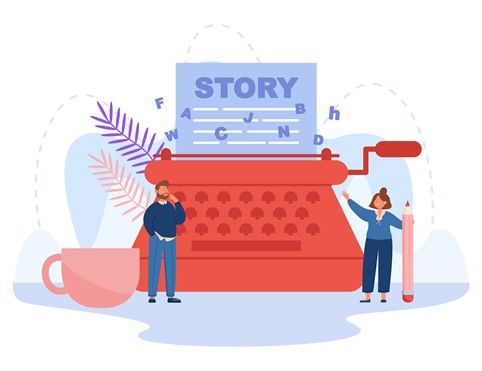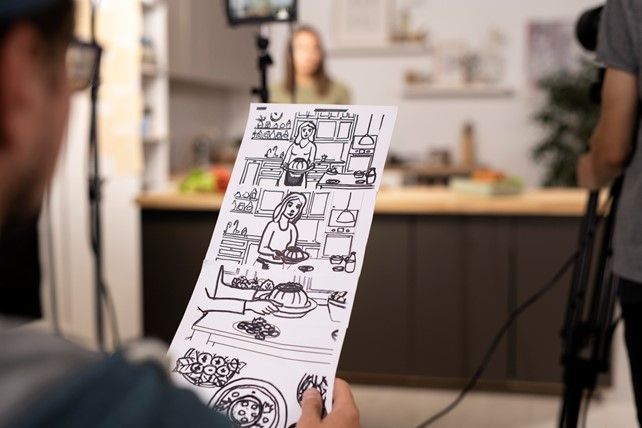
Writing the script for an online course with animated characters

Writing a good animated episode for eLearning is subject to a number of cinematic rules, especially in the writing and design phase. Let's analyze the fundamental steps
Creating an e-learning course means being able to master different communication languages, from writing to audiovisuals, passing through the creation of original and engaging contents.
This reason has led many instructional designers, in recent years, to use one of the most interesting techniques for the realization of a course: the animated episode.
The animated episode, or explainer with characters, is a product that is particularly appreciated by customers and end users, essentially for three reasons: it is engaging, it allows you to tell the best practices for a given topic, and it is an easy-to-use content.
However, writing a good explainer is subject to a number of cinematic rules, especially in the writing and design phase.
In our previous articles we have already discussed topics related to the use of animated explainers in eLearning but, here, we will analyze the basic steps for writing a script for a single episode.
Where do we start?
Here we are, sitting in front of our computer, ready to write a screenplay. It will be our e-learning course, we are ready to face the activity full of enthusiasm but, where do we start?
Syd Field, one of the greatest exponents of U.S. film writing, in his essay The Screenplay comes to our aid: to write a screenplay is to give life to a process that can develop organically and continuously; a craftsmanship that can reach the heights of art.

It is therefore a creative process, composed of precise steps to be followed in order to give body to a product full of writings and revisions of the work.
For this reason, he who begins well is halfway through the work.
Writer's anxiety, or the difficulty of having to start from a blank sheet of paper, is soon eradicated: just start from an outline (a client's request, for example), a precise topic (best practices for identifying the computer scam known as phishing) or a set list that we have already set.
In general, I like to define this element as the idea, which is what it all starts with. The idea is the fuse that allows us to ignite our creativity, until the big explosion: the final course.
The synopsis
 When we work on a screenplay, we must therefore move away from any generic topic for a precise, focused approach to what we want to explain to the learner.
When we work on a screenplay, we must therefore move away from any generic topic for a precise, focused approach to what we want to explain to the learner.
Starting to write a screenplay means first of all describing its synopsis, that is, what our story tells about one or more characters following a certain line of action, be it dramatic or comic.
It is a gradual process that must allow us to first find the topic and then structure the story we are going to tell and, therefore, the script of our explainer.
Therefore, it is necessary to be clear about each step and to move forward with precision, to go back, to fix what is not convincing and then to continue having the path clear in front of our eyes.
The synopsis for an episode that will be part of an e-learning course will therefore tell:
- A brief excursus on the characters
- The problem and its setting
- How the problem imposes itself on the characters
- What the characters do to solve the problem
- The conclusion
Writing the synopsis for a 3-5 minute animated explainer will then involve writing a one or two page descriptive document within which we will address the topics we will develop within the script, adding dialogue and descriptions of environments.
"Mr. Rossi is at work at his desk, working for a long time on a challenging project when, all of a sudden, he receives an email. The email appears to be from his bank and, within the body, there is a reference to the need for an immediate password change. Rossi, concerned by what he reads, decides to click on the link at the end of the email.
And so on.
Write your idea, thinking about the topic you want to reach and about characters and stories to tell.
Highlight the problem and find a first solution.

Define the action in 3 or 4 pages and then reduce to 4 or 5 paragraphs. Reread them and revise the content until you are certain of your subject.
Screenplay writing
Writing a screenplay is a lot of analyzing, rewriting, and thinking.
It certainly needs a certain amount of creativity and talent but, nevertheless, you need to know some technical information about the presentation of the final document.
There are several ways to write a screenplay. I, for example, prefer the American-style structure, which involves a particular formatting of texts according to the information we want to communicate.
We could talk for pages and pages about the style and formatting of a screenplay but, in summary, American-style screenwriting involves the use of:
- Courier font size 12 and wide margins on the sides of the paper;
- Use of capital letters for character names and scene headings;
- Inclusion of scene descriptions and space-time conditions.
The Scene Header
When writing a script for an animated episode, we must keep in mind that we may be working with an extended team: our collaborators and our client's revision team.
For this reason, we need to share information about our story in a technical format that makes it easy for those who will have to work on it to read it.
Thus, before writing the dialogue, it will be necessary to include in the header, in capital letters:
- INT., if the scene will take place indoors;
- EXT., if the scene will take place outdoors;
- DAY, if the scene will take place during the day;
- NIGHT, if the scene will take place at night;
- "SUMMARY DESCRIPTION OF THE SCENE"
Here is an example:
INT. OFFICE OF MARIO ROSSI - DAY
Description
After alerting our readers and/or contributors to the setting in which the scene will take place, we can move on to a quick rundown of what will happen at the beginning of our episode.
The description alerts the reader to information about the setting, the actions, and how the characters interact with the setting or each other.
Be very careful: description is usually free of literary mannerisms and is used to describe environments and actions clearly and succinctly. You can use documents from outside the script to possibly "go wild" in describing characters, their characters, environments and furnishings.
Try, here, to limit yourself to a description of the type:
We see MARIO ROSSI, an employee hired a few months ago at Esempio, juggling papers, document reviews and video calls with his client. Suddenly, a notification on his PC catches his attention...
Dialogues
Let's move on to the most interesting part of a screenwriter's job: the dialogues.

First of all, the dialogues must be credible. This is one reason why it is said that writing a screenplay means rewriting a script.
It is a work of revision, of attention to details and, above all, of comparison with reality.
It is necessary to ask oneself often: is this thing plausible? Could it happen to me or to someone I know? Is it in line with my client's needs?
A careful instructional designer gathers feedback from the client from the first draft of the script, trying to mediate between their creativity and the response to any briefs or technical topics.
Within a dialogue, we can certainly use idioms, narrative devices of any kind, but, be careful, we must never shift the focus from the story and our objective: to explain a problem and how to solve it. In short, to teach something.
The dialogue is presented in the script with the name of the character who is speaking followed by the spoken word:
MARIO ROSSI
Oh, an email...You need to log in to check your bank account. It will be better to understand what is going on.
A tip: there are numerous template documents to download and use within the content writing platform so you don't have to start from scratch. This is the best way to avoid making mistakes.
Another tip: there are hundreds of thousands of movie scripts available for download on the web, read a few pages and study the way they are written to make the writing technique your own.
The storyboard
After writing the script, the time has come to create the storyboard.
 The storyboard is a sequence of images in which the scenes and characters are presented. The images are accompanied by a description that communicates the type of shot to be used, any transitions and, what I personally find very useful, the part of the dialogue related to the script.
The storyboard is a sequence of images in which the scenes and characters are presented. The images are accompanied by a description that communicates the type of shot to be used, any transitions and, what I personally find very useful, the part of the dialogue related to the script.
At this point we have, essentially, two paths to take.
The first way you can go, if you are good at drawing or if you have a good designer in your team, is to make all the drawings by hand. This will involve more effort but will allow you to tweak many things before going into development.
The second way, the one I prefer, is to start setting up characters, scenery, and objects in your chosen development environment (be it motion graphics software or another product) and collect a series of screenshots that will allow the team to visualize a result very close to the final result without giving the feeling of a sketch.
When we make a script and a storyboard project for an animated series, creativity is not enough: it is necessary to aim at the goal and be able to convince the learner with an engaging product that speaks a credible language.
Try, write and, above all, rewrite!
Translated with www.DeepL.com/Translator
Did you like this article? Sign up for the newsletter and receive weekly news!
Subscribe to NewsletterComments:
No comments are in yet. You be the first to comment on this article!